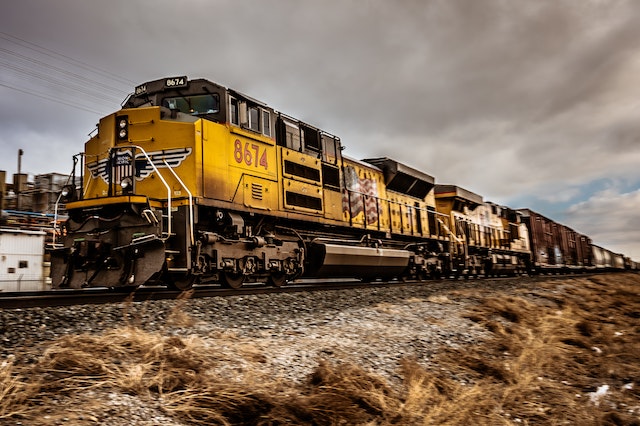
Doran & Murphy represents many railroad engineers, conductors, and brakemen who have developed cancer due to workplace exposures to asbestos, diesel exhaust, and silica sand. An often overlooked exposure in these cancer cases is asbestos exposure while these workers are switching cars at the factories of railroad customers. In the past, railroads regularly delivered asbestos products to and from asbestos companies which manufactured and sold asbestos containing products, such as roofing shingles, drywall, joint compound, pipe insulation, and cement/transite pipe.
A clear example of this type of hazardous exposure is best illustrated by looking at a case we worked on for a Union Pacific client with mesothelioma who worked in Texas and Oklahoma. This railroad worker was a conductor and brakeman and switched cars at the Johns-Manville plant in Denison, Texas.
As part of regularly switching cars at the Johns-Manville Denison plant, our client had significant exposures to asbestos dust, both inside the plant and in the ambient outdoor air. Importantly, a May 1977 EPA report (Report 2-77-098) conducted after an extensive investigation of the Denison J-M plant included the following diagram showing the railroad tracks:
Railroad workers who switched cars at this asbestos manufacturing plant were exposed to asbestos dust from the massive waste pile at the facility which is shown near the railroad tracks. The May 1977 EPA report concluded that:
“Field tests conducted at the Johns-Manville asbestos cement pipe plant
at Denison, Texas indicated that asbestos could be detected in the ambient
air surrounding the plant for distances in excess of 10 km . . .It is believed that this finding is of considerable importance because
of the possible adverse health effects which might be associated with the
asbestos levels in the ambient air. Recent studies reported in the
literature have indicated an association between mesothelioma,
induced cancer, and the presence of an asbestos manufacturing plant with
people dwelling nearby.Emission testing of the waste fines dumping operation confirmed it to
be a significant source of asbestos emissions. Application of the emission
control practices of bagging and slurrying the fine waste substantiated the
estimated reduction in the emissions. Crushing and leveling tests were conducted and these activities were found to be significant emissions sources at the time of operation. It was calculated by atomic absorption analysis that asbestos was emitted at the level of 14,500 to 89,000 ug per second, depending on the meteorological conditions, from crushing activities; while leveling of the fines gave asbestos emissions of 48,000 ug per second for old fines and 200,000 ug per second for fresh fines.”
(pg 4-5).
“This plant is located in that part of the southwest which receives less than 1 meter of rain annually. Thus, the surface of the waste pile is extremely dry most of the year and favors relatively high emission rates.”
(pg 23).
Alarmingly, the EPA report includes information about the various processes at the J-M plant and the huge resulting asbestos fiber emissions:
- From the active dump site- 90 x 1012 asbestos fibers per hour (90 trillion fibers per hour)
- From crushing the rejected pipe– 9 x 1012 asbestos fibers per hour (9 trillion fibers per hour)
- From the inactive pile- 18 x 1012 asbestos fibers per hour (18 trillion fibers per hour)
(pg 23-24).
Despite these huge exposures (trillions of asbestos fibers per hour!) and hazardous working conditions, the railroad never provided any respiratory protection to workers, never tested or inspected the railroad workplace including those conditions found at the Johns-Manville plant, and never trained or educated workers about asbestos hazards.
The railroad can’t escape responsibility because its workers were off-site. An experienced railroad cancer attorney, like our firm, can help to prove that the railroad is still liable. In fact, our office has documents showing that Union Pacific and other railroads knew about the possibility of hazardous exposures at these asbestos company customers. The hazard of railroad worker exposure when switching industries was addressed at meetings of the railroad trade group known as the Association of American Railroads (AAR). During one AAR meeting in May 1982, the minutes show Union Pacific Railroad’s Chief Medical Director Dr. Ernest Rouse stated, “[t]he exposure of workers is at a maximum in the mining, milling and handling industries and the utilization of the products in manufacturing.”
Despite this awareness, the railroad failed to implement any of these industrial hygiene methods in the railroad workplace, including at the J-M Denison plant where they assigned rail workers to switch cars. The simple fact is that if UPRR had conducted an inspection at the Johns-Manville Denison plant where they required engineers, brakemen, and conductors to work, they would have observed the obvious hazards created by the asbestos pipe waste:
(EPA Report, pg 45).
Railroad workers who develop cancer should make a list of all the different locations where they worked for the railroad, including those locations where asbestos products were manufactured. The exposures of railroad engineers, conductors and brakeman in cancer cases against the railroad should consider these very significant but sometimes overlooked exposures. Even though these hazardous exposures took place at the factories and properties owned by railroad customers, the railroads are legally responsible for any resulting cancer, even if it develops many years or decades after the hazardous exposures.
If you or a family member worked for a railroad and developed cancer (mesothelioma, lung, throat, esophageal, laryngeal, stomach, intestinal, kidney, or bladder) due to asbestos, diesel exhaust, silica or any other dusts or fumes, please feel free to reach out to the cancer attorneys at Doran & Murphy PLLC.





